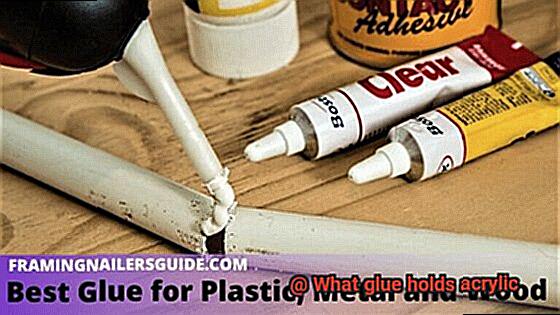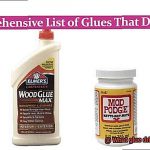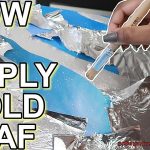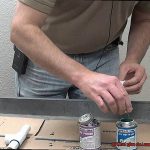Imagine this: You pour your heart and soul into creating a stunning frame for your cherished artwork, only to watch it crumble apart in mere days. Frustrating beyond belief, right? Well, fret no more. Today, we’re about to unravel the mystery behind finding the perfect glue that holds acrylic together like a match made in DIY heaven.
Acrylic, an incredibly versatile and visually captivating material, is taking the crafting world by storm. Its crystal-clear appearance adds a touch of elegance to any project. But here’s the catch – finding the right glue that seamlessly bonds this marvelous material while ensuring durability and longevity can be quite the challenge.
In this blog post, we’ll dive headfirst into the captivating realm of adhesives, uncovering the holy grail of glues for working with acrylic. Whether you’re a passionate DIY enthusiast, an artistic soul seeking to repair a broken acrylic masterpiece, or simply someone intrigued by this topic – fear not. We’ve got you covered.
Prepare yourself as we embark on an exploration of adhesive options tailored specifically for bonding acrylic. Brace yourself for the critically acclaimed methyl methacrylate (MMA) glue that has taken the crafting world by storm. Brace yourself for revolutionary structural acrylic adhesive that will make your projects stand strong against time. And brace yourself for classic epoxy resin – a tried-and-true favorite.
But wait. There’s more. We won’t stop there. We’ll also address crucial considerations such as setting and curing times, flexibility, and resistance to heat and moisture. By understanding these vital factors, you’ll gain the power to make informed decisions about which adhesive best suits your project.
So if you’re tired of weak glue bonds causing endless frustration, join us on this thrilling adhesive adventure and unlock the secret glue that will forever revolutionize the way you work with acrylic.
Types of Glues for Bonding Acrylic
Contents
- 1 Types of Glues for Bonding Acrylic
- 2 Adhesive Compatibility with Acrylic
- 3 Commonly Used Glues for Bonding Acrylic
- 4 Application Techniques for Using Glue on Acrylic
- 5 Considerations for Specific Projects Involving Acrylic
- 6 Safety Precautions When Working with Glue and Acrylic
- 7 Pros and Cons of Different Glues for Bonding Acrylic
- 8 Tips and Tricks for Choosing the Right Glue for Your Project
- 9 Conclusion
Are you ready to embark on a project involving acrylic bonding? The glue you choose will be the backbone of your creation, ensuring a strong and enduring bond. In this article, we will take a deep dive into the realm of glues designed explicitly for acrylic bonding. Join us as we unravel the unique properties of these glues and guide you towards selecting the perfect adhesive for your project.
Cyanoacrylate Adhesive – Super Glue:
One of the most beloved options for acrylic bonding is cyanoacrylate adhesive, affectionately known as super glue. This adhesive works its magic by forming an instantaneous and unyielding bond between surfaces. Ideal for small bonding areas, cyanoacrylate adhesive may not be the best choice for larger or load-bearing applications due to its tendency to become brittle over time.
Solvent Cement – The Power of Fusion:
Enter solvent cement, a trusted companion in the world of acrylic bonding. This glue works wonders by chemically melting the acrylic surfaces, seamlessly fusing them together as they dry. With its robust and enduring bond, solvent cement is the go-to choice for permanent applications. What’s more, it dries transparently, rendering the bond virtually invisible.
Acrylic Adhesive – Swift and Mighty:
For those seeking speed and strength, acrylic adhesive, also known as acrylic glue or resin, is here to save the day. A clear liquid that transforms into a resilient plastic-like substance upon curing, this adhesive forges a potent bond between acrylic surfaces in no time at all. Its quick drying time makes it particularly suitable for projects demanding swift and reliable bonding.
Epoxy Adhesives – Resilience Perfected:
In the realm of acrylic bonding, epoxy adhesives reign supreme in versatility. Consisting of two components – a resin and a hardener – these glues must be mixed before application. Once blended, epoxy forms an unyielding bond capable of withstanding harsh environments and high temperatures. This adhesive is a match made in heaven for bonding dissimilar materials or when a gap-filling adhesive is required.
UV-Curing Adhesives – The Brilliance of Clarity and Strength:
Elevating the world of acrylic bonding to new heights, UV-curing adhesives are rapidly gaining popularity. These magical glues require exposure to ultraviolet light for curing, resulting in a bond that boasts exceptional clarity and strength. Perfect for small to medium-sized bonding areas, UV-curing adhesives offer an unparalleled level of transparency.
Conclusion:
Bonding acrylic requires careful consideration when selecting the ideal glue for your project. Cyanoacrylate adhesive, solvent cement, acrylic adhesive, epoxy adhesives, and UV-curing adhesives are just a few of the options available.
Adhesive Compatibility with Acrylic
In our previous installment, we marveled at the remarkable properties of various glues, from the swift and powerful acrylic adhesive to the unwavering strength of epoxy. Now, let us plunge deeper into the realm of adhesives that harmonize with acrylic, while also uncovering the essential role of surface preparation.
Types of Adhesives Compatible with Acrylic:
Solvent-based Cement:
Picture two puzzle pieces sliding together flawlessly – that’s the sorcery of solvent-based cement for bonding acrylic. This beloved adhesive delicately softens the acrylic surface, allowing it to fuse seamlessly. Seek out solvent-based cements infused with methylene chloride or dichloromethane for optimal results.
Cyanoacrylate Glue (Super Glue):
You’ve undoubtedly heard whispers of super glue – that mystical adhesive that wields the power to bond in mere seconds. Cyanoacrylate glues are no exception when it comes to their affinity for acrylic. However, tread carefully, as not all super glue variations are equipped for acrylic bonding. Be sure to select a specialized formula designed exclusively for this magical union.
Epoxy Adhesives:
For those seeking unwavering strength and durability, look no further than epoxy adhesives for bonding acrylic. These potions consist of two components – resin and hardener – which intertwine to create an unbreakable bond once mixed. With their superior fortitude, epoxy adhesives are a formidable choice for heavy-duty applications, ensuring your acrylic project stands the test of time.
UV-Curing Adhesives:
When urgency is paramount, UV-curing adhesives swoop in as the saviors of swift bonding. These enchanting adhesives are activated by basking in the radiance of ultraviolet light, resulting in a rapid and robust bond. Industries that demand quick and dependable bonding often turn to UV-curing adhesives when working with acrylic.
Commonly Used Glues for Bonding Acrylic
In this captivating journey, we will explore the different types of glues commonly used for bonding acrylic and uncover their unique advantages and considerations. So, grab your favorite adhesive wand and let’s dive into this enchanting subject.
First on our magical journey is cyanoacrylate adhesive, also known as super glue. This adhesive works like a charm with its fast-drying and strong bonding properties. When in contact with moisture, cyanoacrylate adhesives create a chemical reaction that swiftly bonds acrylic surfaces together. It’s a quick and reliable choice for many acrylic bonding projects.
Next up is solvent cement, the secret weapon of the acrylic wizard. Developed specifically for bonding acrylic pieces, solvent cement works its magic by chemically softening the surfaces of the acrylic. When pressure is applied, these surfaces fuse together seamlessly. Take care to apply solvent cement sparingly to avoid excessive melting or damage to the acrylic. With its ability to create strong and flawless bonds, solvent cement is a powerful ally for any acrylic bonding endeavor.
Now, let’s turn our attention to epoxy resin, a versatile adhesive that can work wonders with acrylic. Comprising of two components, a resin and a hardener, epoxy resin must be mixed before application. Once mixed, this adhesive offers excellent bonding strength that can withstand both small and large-scale projects. However, it’s important to note that epoxy may not be as transparent as other glues, making it less suitable for applications where clarity is essential. But if you’re seeking strength and durability, epoxy resin will be your trusty sidekick.
But wait, there’s more. In our quest for the perfect bond, we mustn’t forget about specialized acrylic adhesives. These magical potions are specifically formulated for bonding acrylic and offer superior strength and clarity. Often coming in two-part systems that require mixing before use, these adhesives provide reliable and precise bonding results. Though they may come with a slightly higher price tag, their performance and reliability make them the ideal choice for demanding applications.
Application Techniques for Using Glue on Acrylic
In our quest to become acrylic wizards, we have already discovered the powers of cyanoacrylate adhesive, solvent cement, epoxy resin, and specialized acrylic adhesives. But now, it’s time to delve into the application techniques that will help us create strong and durable bonds using glue on acrylic. So, grab your brushes and syringes as we explore the secrets to achieving magical results.
Prepare for Success:
Before embarking on our gluing adventure, we must prepare our acrylic surfaces for a flawless bond. Cleanliness is key. Gently scrub away any dust or debris using a mild detergent or alcohol-based cleaner. This step lays the foundation for a solid bond.
Evenness is Key:
To unlock the full potential of our glue, we must apply it evenly and in just the right amount. Too little glue would weaken our bond, while an excess amount would result in messy overflow. Let us consult the manufacturer’s instructions to determine the perfect dosage.
Brushing Technique:
As we wield our brushes with finesse, we gain control over the destiny of our bond. Soft-bristled brushes designed specifically for acrylics will guide us towards even distribution and impeccable precision. With each stroke, our bond becomes stronger.
Precise Dropping:
For intricate or petite pieces of acrylic, we call upon the syringe or dropper to be our faithful companions. With their assistance, we achieve surgical precision in our glue application. Every precious drop falls exactly where it needs to be, ensuring a bond that defies gravity.
Compatibility Check:
Before sealing our fate with glue, let us first test its compatibility with a small, hidden portion of our acrylic piece. This precautionary measure ensures harmony between adhesive and material. Acrylics, like individuals, possess unique qualities that require tailored glues for a perfect match.
Full Coverage:
To forge an unbreakable bond, we must not shy away from commitment. Our glue must embrace the entire bonding area, leaving no space for weakness or unsightly gaps. With thorough coverage, our bond becomes a fortress of strength and beauty.
Considerations for Specific Projects Involving Acrylic
In our previous foray, we unraveled the secrets of adhesive sorcery and discovered the key to crafting enchanting bonds. Now, let us ascend to new heights of acrylic mastery as we explore the considerations for specific projects involving this bewitching material.
Embarking upon a project with acrylic requires a keen mind and a discerning eye. So gather your creative cauldrons and prepare to unlock the mysteries that lie ahead.
First and foremost, the choice of glue is paramount. Acrylic, you see, is no ordinary material. It demands an adhesive that is tailored to its unique properties, ensuring a bond that is both robust and enduring. Beware, my friends, for not all glues possess the power to tame this mesmerizing substance. Seek out the chosen one – the adhesive crafted specifically for uniting acrylic materials.
Now, let us delve into the realm of acrylic varieties. Cast acrylic, extruded acrylic – each possesses its own character and charm. It is imperative that we select a glue that dances harmoniously with the specific type of acrylic we wield. For in this alchemical dance lies the secret to success. Let us not stumble upon a potion gone awry.
But wait. We must not forget the nature of the very project we undertake. Will it be grand and colossal or petite and delicate? Shall it brave the tempestuous wilderness or bear witness to unyielding forces? These factors hold sway over our choice of glue. Should our creation face nature’s wrath or endure arduous trials, we must seek solace in a glue that boasts unparalleled strength and unwavering resistance. Let not our masterpieces crumble under pressure.
Ah, aesthetics – the ethereal allure of beauty. Acrylic, known for its crystalline clarity, beckons us to tread lightly on its pristine surface. Thusly, we must choose a glue that leaves naught but a trace – no visible residue, no disfiguring discoloration. Let us weave a spell so seamless that our glue joints become invisible, a testament to our craft.
In the realm of application methods, glues reveal their preferences. Some yearn for precision, delighting in the touch of a syringe or the finesse of a small nozzle. Others revel in the grandeur of large surface bonding. Choose your wand with care, dear friends, and let your adhesive flow with grace and elegance.
Safety Precautions When Working with Glue and Acrylic
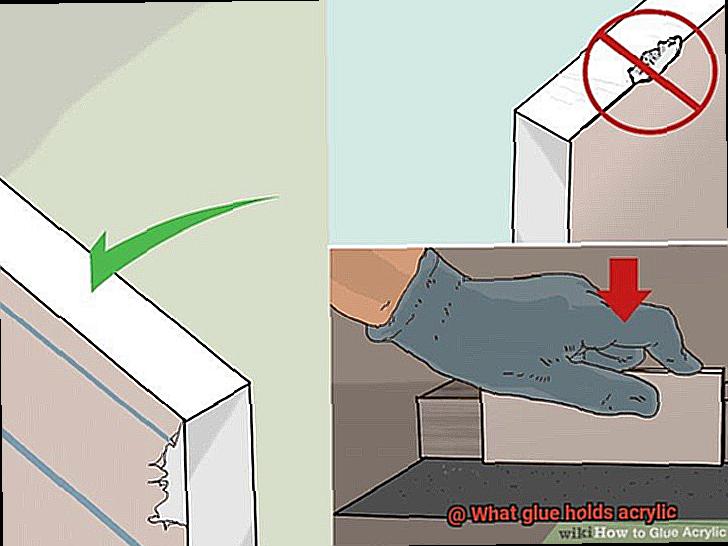
Embarking on a creative journey with glue and acrylic is exhilarating, but safety should always be at the forefront. In this article, we will delve into the essential safety precautions necessary to ensure a secure and enjoyable crafting experience. From working in a well-ventilated area to wearing protective gear, let’s explore the world of safe and successful crafting.
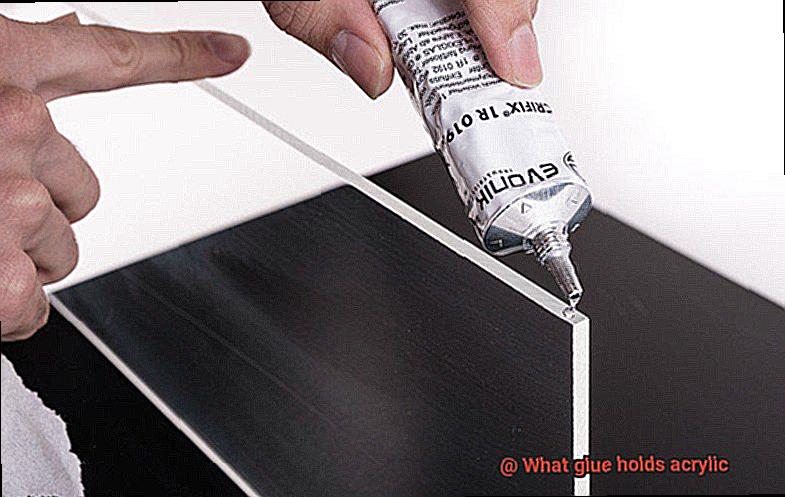
Breathe Easy with Ventilation:
Toxic fumes emitted by certain glues can pose a serious health risk if inhaled. Prevent any dizziness, headaches, or respiratory issues by working in a well-ventilated area. Open those windows wide or utilize a fan to let fresh air flow freely throughout your workspace.
Gear Up for Protection:
When it comes to glue and acrylic, don’t leave safety up to chance. Shield your hands from corrosive or irritating glues by wearing protective gloves. And never forget your trusty goggles. They are your eyes’ superheroes, guarding against accidental splashes or spills.
Instructions: Your Crafting Bible:
Become acquainted with the instructions provided by the glue manufacturer before diving into your project. Different adhesives come with specific guidelines for usage and safety precautions. By studying these instructions thoroughly, you can ensure that you’re using the glue correctly and safely.
A Clean Workspace for Peace of Mind:
Slippery surfaces caused by glue spills are accidents waiting to happen. Maintain a clean and organized workspace by promptly wiping up any spills. Dispose of waste materials properly to keep hazards at bay and create a safe environment for yourself and others.
Handle Acrylic with Tender Love:

Acrylic sheets may possess a fragile beauty, but they can also be sharp and brittle. Treat them gently, avoiding excessive pressure or accidental drops onto hard surfaces. By handling acrylic with care, you minimize the risk of breakage or injury, ensuring stunning results every time.
Accidental Contact: Swift Action Required:
In the event of skin contact with glue, wash the affected area immediately with soap and water. Should irritation persist, don’t hesitate to seek medical attention. Similarly, if glue finds its way into your eyes, flush them thoroughly with water for a minimum of 15 minutes. Remember, your well-being is priceless, so consult medical professionals without delay.
Pros and Cons of Different Glues for Bonding Acrylic
Prepare to embark on a thrilling journey through the realm of glues as we delve into the fascinating world of bonding acrylic. With my expertise in all things adhesive, I have curated a treasure trove of research notes to guide you in making the ultimate glue choice. So, don your safety goggles and get ready to be amazed.
Acrylic Cement or Solvent-Based Adhesives:
Pros:
- Crafted specifically for bonding acrylic, these glues create an unbreakable bond with remarkable strength.
- The resulting fusion is practically invisible, rendering it perfect for projects that demand seamless perfection.
- Ideal for heavy-duty applications or when structural integrity is paramount.
Cons:
- Beware. These glues can be toxic and unleash potent fumes during application, necessitating adequate ventilation.
- Delicate or small-scale projects may suffer due to the overpowering chemical composition of these adhesives.
Epoxy Glues:
Pros:
- Renowned for their Herculean strength, epoxy glues forge a bond impervious to water, heat, and chemicals.
- A match made in heaven for projects that require unwavering durability and longevity.
- Once cured, they leave behind a crystal-clear finish that will dazzle your senses.
Cons:
- Mixing resin and hardener can be a messy affair, demanding meticulous handling skills.
- Exercise caution. Due to their toxicity, protective gear is a must-have when working with epoxy glues.
Cyanoacrylate or Super Glues:
Pros:
- These marvels of adhesive technology offer instantaneous bonding and dry clear, making them a savior for quick fixes or small projects.
- Effortless to use with no fuss of mixing or specialized tools required.
- Can work wonders when bonding acrylic to other materials like wood or metal.
Cons:
- Beware of limitations. When it comes to larger or load-bearing applications, the bond strength may not match that of acrylic cement or epoxy glues.
- In the unfortunate event of application mishaps, removing these super glues can be a herculean task.
Tips and Tricks for Choosing the Right Glue for Your Project
When working with acrylic, choosing the right glue is critical to ensure a successful project. The ideal glue should not only provide a strong bond but also be compatible with acrylic and leave a flawless finish. In this article, we will delve into some expert tips and tricks to help you select the perfect glue for your acrylic project.
Understanding the Properties of Acrylic:
Before diving into your project, it is crucial to have a solid understanding of the unique properties of acrylic. This lightweight and durable material boasts transparency, high impact resistance, and excellent weatherability. Armed with this knowledge, you can select a glue that will effectively adhere to acrylic’s distinct characteristics.
Consider the Type of Bond Required:
The type of bond needed for your project will dictate the appropriate adhesive choice. Whether you require a permanent bond or a temporary one that allows for repositioning, identifying your specific needs will guide you towards the right adhesive solution. Opt for a reliable adhesive that forms a long-lasting connection for permanent bonds, while selecting a repositionable adhesive if flexibility is important.
Check for Compatibility:
Not all glues are suitable for acrylic, making compatibility an essential factor to consider. To avoid damage or discoloration, look for adhesives explicitly designed for bonding acrylic or plastics. These specialized glues are formulated to provide excellent adhesion without compromising the integrity of the material.
Explore Adhesive Options for Acrylic:
Multiple adhesive options are available for bonding acrylic projects. Solvent-based adhesives are often favored due to their ability to chemically melt the surfaces of the acrylic, resulting in a robust bond. Alternatively, acrylic-based adhesives are specifically formulated to bond acrylic materials effectively and are typically applied using tubes or cartridges.
Consider the Application Method:
The application method used can significantly impact the success of your project. Some adhesives require specific tools or equipment, while others may need to be mixed or activated before use. Choose an application method that aligns with your comfort level and skill set to ensure precise and hassle-free application.
Test Before Committing:
Before committing to applying the glue on your entire project, it is wise to conduct a small test on an inconspicuous area of the acrylic. This preliminary test allows you to evaluate crucial factors such as bond strength, drying time, and any potential side effects like discoloration or damage. By carefully testing the adhesive, you can ensure that you have chosen the perfect glue for your unique project requirements.
hT6Ow_cBTps” >
Conclusion
When it comes to bonding acrylic, finding the right glue is crucial. You need a glue that can hold this versatile material securely and ensure a strong and durable bond. Luckily, there are several options available that are specifically designed for adhering acrylic surfaces together. From solvent-based adhesives to specialty acrylic glues, you have choices to suit your specific needs.
One popular choice for bonding acrylic is solvent cement. This adhesive works by chemically melting the surface of the acrylic, creating a strong bond as it dries. It’s important to note that solvent cement is typically used for joining two pieces of acrylic together rather than for general purpose bonding.
Another option is an epoxy resin adhesive. Epoxy resins are known for their excellent bonding strength and versatility. They can be used on various materials, including acrylic. These adhesives typically come in two parts – a resin and a hardener – which need to be mixed together before application.
For those looking for a quick and easy solution, there are also instant adhesives or cyanoacrylate glues available. These glues bond quickly and provide good strength when used on properly prepared acrylic surfaces.
When using any adhesive on acrylic, it’s essential to ensure that the surfaces are clean and free from any dirt or grease. Proper surface preparation will help maximize the effectiveness of the glue and ensure a solid bond.
In conclusion, choosing the right glue for bonding acrylic is crucial to achieve strong and long-lasting results. Whether you opt for solvent cement, epoxy resin adhesive, or instant glue, make sure to follow proper surface preparation guidelines for optimal bonding performance.

